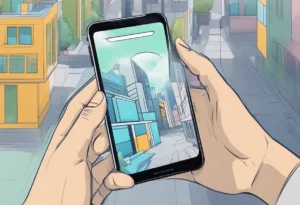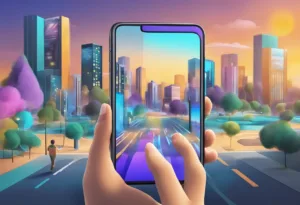Augmented reality (AR) is a technology that has been around for several years, but it has only recently started to gain mainstream attention. AR is a technology that overlays digital information onto the real world, creating an immersive experience for the user. It has the potential to revolutionize many industries, from gaming and entertainment to healthcare and education. One of the primary uses of augmented reality is in consumer applications. AR can be used to create interactive experiences for consumers, such as virtual try-ons for clothing and makeup, or interactive product demonstrations. AR can also be used to create immersive gaming experiences, where the player interacts with a virtual world overlaid on the real world.
Another area where AR is seeing increased use is in industrial and professional settings. AR can be used to provide workers with real-time information, such as instructions or schematics, overlaid onto the real world. This can increase worker productivity and safety, as well as reduce errors. AR can be used to create virtual training simulations, allowing workers to practice tasks in a safe, controlled environment.
Key Takeaways
- Augmented reality is a technology that overlays digital information onto the real world, creating an immersive experience for the user.
- AR is seeing increased use in consumer applications, such as virtual try-ons and immersive gaming experiences.
- AR is also being used in industrial and professional settings to increase productivity and safety, and to provide virtual training simulations.
Defining AR and Its Core Technologies
Augmented Reality (AR) is a technology that overlays digital information onto the real world. It enhances the user’s perception of the physical environment by adding computer-generated content, such as images, sounds, or text. AR technology uses various hardware components, such as cameras, displays, sensors, and GPS, to create a seamless blend between the real and virtual worlds.
The core technologies that enable AR are computer vision, 3D modeling, and data processing. Computer vision algorithms analyze the real-world environment and identify objects and surfaces that can be augmented. 3D modeling software creates virtual objects that can be overlaid onto the real world. Data processing algorithms manage the input and output of information between the user and the AR system.
Differences Between AR, VR, and Mixed Reality
AR is often confused with Virtual Reality (VR) and Mixed Reality (MR). While all three technologies involve the use of computer-generated content, they differ in their level of immersion and interaction.
VR is a fully immersive experience that replaces the real world with a virtual one. Users wear headsets that display a 360-degree view of a computer-generated environment, and they can interact with it using hand-held controllers or body movements.
MR is a hybrid of AR and VR, where virtual objects are integrated into the real world and interact with it in real-time. Users can see and interact with both the real and virtual worlds simultaneously.
AR, on the other hand, is a non-immersive experience that enhances the real world with virtual content. Users can see and interact with the real world while digital information is overlaid onto it. AR can be experienced through smartphones, headsets, or glasses, making it a more accessible technology than VR or MR.
AR has numerous applications in various industries, including gaming, education, healthcare, and entertainment. As the technology continues to evolve, it is expected to become more immersive and interactive, opening up new possibilities for how we interact with the world around us.
Uses of Augmented Reality

Augmented Reality (AR) is a technology that allows users to experience digital content in a real-world environment. The technology has gained popularity in recent years due to its ability to enhance user experience in various fields. Here are some of the uses of AR:
- Education: AR can be used in the education sector to create interactive learning experiences. For instance, students can use AR to visualize complex concepts such as human anatomy, chemistry, and physics.
- Retail: AR can be used in retail to enhance the shopping experience. Customers can use AR to try on clothes, visualize furniture in their homes, or even see how a car would look in their driveway.
- Advertising: AR can be used in advertising to create engaging and interactive campaigns. For example, a company can use AR to create a virtual product demonstration or a game that promotes their product.
- Tourism: AR can be used in tourism to provide visitors with an interactive and immersive experience. For instance, visitors can use AR to learn about the history of a place or to visualize how it looked in the past.
- Healthcare: AR can be used in healthcare to provide doctors with a better understanding of a patient’s condition. For example, doctors can use AR to visualize a patient’s anatomy during surgery.
- Real Estate: AR can be used in real estate to provide potential buyers with an immersive experience of a property. For instance, buyers can use AR to visualize how a property would look with different furniture or decor.
- Gaming: AR can be used in gaming to create immersive and interactive experiences. For example, the popular game Pokémon Go uses AR to allow players to catch virtual creatures in the real world.
- Manufacturing: AR can be used in manufacturing to provide workers with real-time information about a product or process. For instance, workers can use AR to visualize how a product should be assembled.
- Sports: AR can be used in sports to provide fans with an immersive experience. For example, fans can use AR to visualize player statistics or to see replays from different angles.
- Military: AR can be used in the military to provide soldiers with real-time information about their surroundings. For instance, soldiers can use AR to visualize enemy positions or to see the location of friendly forces.
- Art and Design: AR can be used in art and design to create interactive and immersive experiences. For example, artists can use AR to create virtual sculptures or to add digital elements to their paintings.
AR in Consumer Applications
Augmented reality has found its way into various consumer applications, enhancing user experiences and providing unique opportunities for businesses. In this section, we will explore some of the ways that AR is being utilized in retail and shopping experiences, gaming and entertainment, and education and learning.
Retail and Shopping Experiences
AR is revolutionizing the way people shop and interact with products. Retailers like IKEA have developed AR apps that allow customers to visualize how furniture would look in their homes before making a purchase. This technology provides a more immersive and interactive shopping experience, making it easier for customers to make informed decisions.
AR is being used in marketing to provide customers with digital information about products. For example, some retailers are using AR to create interactive displays that allow customers to learn more about products by scanning them with their smartphones.
Gaming and Entertainment
One of the most popular applications of AR is in gaming and entertainment. The release of Pokemon Go in 2016 brought AR gaming to the mainstream, and since then, more games have incorporated AR into their gameplay. AR provides a more immersive gaming experience, allowing players to interact with their surroundings in new and exciting ways.
AR is also being used in entertainment, such as concerts and live events. AR glasses and head-mounted displays are being used to provide audiences with a more interactive and engaging experience.
Education and Learning
AR is transforming the way people learn and interact with information. AR apps are being developed to provide students with interactive and immersive learning experiences. For example, some apps allow students to explore virtual environments and interact with 3D objects, making it easier to understand complex concepts.
Also, AR is being used in training and simulations. AR glasses and smart glasses are being used to provide workers with real-time information and instructions, improving safety and efficiency. AR is providing consumers with new and exciting ways to interact with products, games, and information. As the technology continues to evolve, we can expect to see even more innovative uses of AR in the future.
Industrial and Professional Use Cases
Augmented Reality (AR) has revolutionized the way industries operate. It provides a powerful tool for training and simulation in manufacturing industries, upskilling employees, and visualizing complex processes. AR-based training programs simulate real-life scenarios, and workers can interact with virtual objects, making it an effective tool for industrial and professional use cases.
Healthcare and Medical Training
AR technology has been used in healthcare and medical training to provide a more realistic and interactive training experience. Microsoft HoloLens, for instance, has been used to train medical students and professionals in surgical procedures and anatomy. AR technology allows students to visualize and interact with medical equipment, models, and simulations, leading to efficient and effective training.
Architecture and Design
AR technology has been used in architecture and design to create 3D models of buildings and structures. This technology allows architects and designers to visualize their designs in a real-world setting, making it easier to identify potential issues and make necessary changes. AR technology has also been used to create virtual tours of buildings, providing a more immersive experience for clients.
Manufacturing and Maintenance
AR technology has been used in industrial manufacturing and maintenance to increase efficiency and reduce downtime. Boeing, for example, has used AR technology to help workers assemble aircraft. AR technology provides workers with step-by-step instructions and visual aids, making it easier to assemble complex parts and reducing the risk of errors. AR technology has also been used in maintenance to help workers identify and repair equipment issues quickly.
AR technology has numerous applications in various industries, including healthcare, architecture, manufacturing, and maintenance. AR-based training programs, 3D modeling, and virtual tours are just a few examples of how AR technology is being used to improve efficiency and provide a more interactive and immersive experience for professionals in various industries.
Technological Advancements and Future of AR

Innovations in AR Hardware and Software
Augmented Reality (AR) technology has seen significant advancements in both hardware and software in recent years. Head-mounted displays (HMDs) have become smaller, lighter, and more comfortable to wear, with high-resolution displays that provide an immersive experience. AR glasses, such as Google Glass and Microsoft HoloLens, have also been developed, which allow for hands-free interaction with digital content.
AR software has also advanced significantly, with the development of ARKit and other software development kits (SDKs) that allow developers to create AR experiences for mobile devices. These SDKs provide access to features such as marker recognition, accelerometer data, and heads-up displays (HUDs), which enable developers to create realistic and interactive AR experiences.
The Role of AR in the Emerging Metaverse
The Metaverse, a term coined by science fiction author Neal Stephenson, refers to a virtual world where users can interact with each other and digital content in a shared space. AR has the potential to play a significant role in the development of the Metaverse, as it allows for the integration of digital content into the user’s real-world environment.
As AR technology continues to advance, it is expected to become more ubiquitous, with an increasing number of users accessing AR via their mobile devices. This trend is expected to continue, with the worldwide number of AR users projected to increase by 330 million by 2024.
AR is also expected to play a significant role in the development of the Metaverse, as it allows for the integration of digital content into the user’s real-world environment. This integration has the potential to create new forms of social interaction, entertainment, and commerce, as users can interact with digital content in a shared space.
The advancement in AR hardware and software has made it possible for developers to create realistic and immersive AR experiences. AR is also expected to play a significant role in the development of the Metaverse, providing users with new forms of social interaction, entertainment, and commerce.
Challenges and Considerations in AR
User Experience and Interaction
One of the main challenges with augmented reality is providing a seamless and intuitive user experience. AR applications must be easy to use and understand, with clear instructions and feedback. The user interface should be simple and unobtrusive, allowing users to focus on the AR content without distractions.
Interaction is another key consideration in AR. Users should be able to interact with the digital world in a natural and intuitive way, using gestures, voice commands, or other inputs. The camera and GPS sensors must be accurate and responsive, providing a smooth and seamless AR experience.
Privacy and Security Concerns
Privacy and security are also important considerations in AR. AR applications may collect data about users, including their location, preferences, and behaviors. This data must be handled responsibly and transparently, with clear privacy policies and opt-in mechanisms.
AR applications may also pose security risks, such as the potential for malicious actors to exploit vulnerabilities in the software or hardware. Developers must take steps to secure their applications, including regular updates and patches, and robust testing and validation.
Providing a seamless and intuitive user experience, and addressing privacy and security concerns are key challenges in AR development. Developers must also consider the camera, GPS, data, digital world, and natural environment to provide the best possible AR experience.
Frequently Asked Questions
What are the top industries where augmented reality is most utilized?
Augmented reality is being utilized in a wide range of industries, including healthcare, education, retail, tourism, and gaming. In healthcare, AR is being used for medical training, patient education, and surgical procedures. In education, AR is transforming traditional learning experiences by making them more interactive and engaging. In retail, AR is being used to enhance customer experiences by allowing them to visualize products in their own space before making a purchase. In tourism, AR is being used to enhance visitor experiences by providing interactive and immersive tours. In gaming, AR is being used to create new and exciting gaming experiences.
What are the four major applications of augmented reality?
The four major applications of augmented reality are marketing and advertising, gaming and entertainment, education and training, and healthcare. In marketing and advertising, AR is being used to create interactive and engaging campaigns. In gaming and entertainment, AR is being used to create immersive and interactive experiences. In education and training, AR is being used to create interactive and engaging learning experiences. In healthcare, AR is being used for medical training, patient education, and surgical procedures.
In what ways is augmented reality transforming educational experiences?
Augmented reality is transforming educational experiences by making them more interactive and engaging. AR is being used to create immersive and interactive learning experiences that allow students to visualize and interact with complex concepts in a way that was not possible before. AR is also being used to create virtual field trips, allowing students to explore and learn about different parts of the world without leaving the classroom. AR is being used to create interactive textbooks and educational games that make learning more fun and engaging.
How does augmented reality differ from virtual reality in practical applications?
Augmented reality and virtual reality are both immersive technologies, but they differ in their practical applications. Augmented reality overlays digital information onto the real world, while virtual reality creates a completely digital environment. In practical applications, augmented reality is being used to enhance real-world experiences, while virtual reality is being used to create completely new and immersive experiences.
Can you give some examples of how augmented reality is used in everyday life?
Augmented reality is being used in everyday life in a number of ways. Some examples include using AR to try on clothes before making a purchase, using AR to visualize furniture in a room before making a purchase, using AR to navigate in unfamiliar places, and using AR to enhance social media filters and effects.
What are the different types of augmented reality technologies currently in use?
There are several different types of augmented reality technologies currently in use, including marker-based AR, markerless AR, projection-based AR, and superimposition-based AR. Marker-based AR uses a physical marker to trigger digital content, while markerless AR uses computer vision to detect and track real-world objects. Projection-based AR projects digital content onto real-world surfaces, while superimposition-based AR overlays digital content onto real-world objects without the need for a physical marker.














